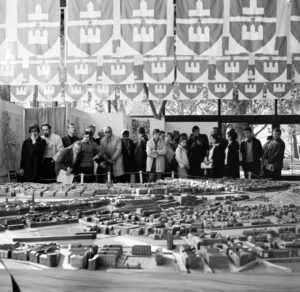
Exposition à l’occasion du 100e anniversaire de l’unification de Pest, Buda et Óbuda (1973). Détail d’une maquette de Budapest à l’échelle 1:500. (Fortepan / Lechner Nonprofit Kft. Dokumentációs Központ)
Protected Urban Spaces
The conceptual history of the historic city centre of Pest (1928-1987)
Gábor Oláh, member of the Geographie-cités laboratory, will present his doctoral thesis in urban studies entitled: “Protected urban spaces. The conceptual history of the historic district of Pest (1928-1987)”.
Friday, March 31
at 2pm
room AS1_23
École des hautes études en sciences sociales
54 boulevard Raspail 75006 Paris
Also in remote mode: https://bbb.ehess.fr/b/mar-bep-aub-mlt
If you wish to attend, please send an email to olah.gabor@btk.elte.hu
This thesis has been realized under the supervision of Marie-Vic Ozouf-Marignier, director of studies at the EHESS and member of the UMR Géographie-cités and Gábor Sonkoly, professor at the Eötvös Loránd University, Budapest.
Jury
Melinda Benkő, Professor, Polytechnic and Economic University of Budapest – reporter
Loїc Vadelorge, Professor, Gustave Eiffel University – rapporteur
Laurier Turgeon, Professor, Laval University – reviewer
Eszter György, Associate professor, Eötvös Loránd University – reviewer
Marie-Vic Ozouf-Marignier, Research Director, EHESS, UMR Géographie-cités – thesis Director
Gábor Sonkoly, Professor, Eötvös Loránd University – thesis director
Summary
Budapest has several historic urban cores, to which the qualification “historic” has been attributed at different times and in different ways. The “youngest” historic centre is on the left bank of the Danube, in Pest. At the turn of the 1920s and 1930s, certain qualifications symbolize the diversity of visions about the past, present, and future of this area: “the old lost Pest”, “the epigone city”, “the young city without historical patina”, “the disordered, outdated, and confused city”. These labels and topoi, which were sources of argument for the conceptions of the future city, testified to the fractures between divergent visions.
Six or seven decades later, these qualifications have changed or even disappeared. While new ones have appeared, those which remain only represent the city in a summary way. On the other hand, the temporal models have increasingly converged towards the city centre of Pest: historicity has become a characteristic and a way of describing aspects of urban life. All this happened without any major changes in the cityscape, urban structure and built environment of these urban areas. The convergence of perceptions of urban space has manifested itself, among other things, in the creation of a protected site on the UNESCO World Heritage List. Sixty years of statements and debates show the transformation of the perception of the inner-city areas of Pest, which at the end of the 20th and the beginning of the 21st century resulted in a protected status with multiple scales and definitions. Society at these two distinct historical moments shows radically different visions of the same urban area. The problem can therefore be seen as the construction of a relationship between a given object – in our case, the city centre of Pest in material, intellectual or conceptual terms – and its past.
This approach questions the urban heritage and the process of heritagisation, and more precisely, admits the hypothesis that through the history of heritage we have a better understanding of the way societies perceive and interpret their urban space. It is therefore necessary to examine heritage processes in a historical context, which is the focus of this research. The concept of the historic district has developed in Pest at a pace that is in line with global and European intellectual movements, while taking into consideration specific local internal elements. This concept can therefore be understood in the international context of urban heritage preservation, whose privileged terrain has become the city centre. Furthermore, the changes in the scale of observation reveal factors that have shaped the unique conceptual history of the Pest city centre.


